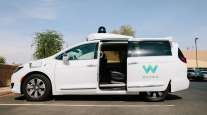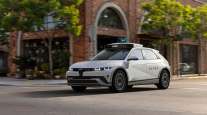Why GM and Waymo Rely on Allies in Self-Driving Race

An automaker like General Motors Co. brings two advantages to the development of self-driving vehicles: knowledge of how to build a car and the factories to do it. Silicon Valley’s biggest entrants into autonomous vehicles, particularly Alphabet Inc., have legions of coders and piles of cash.
Now GM and Alphabet have found someone else to handle the aspects of this historic undertaking that the companies are least adept at doing themselves.
Carmakers hate risking billions of dollars more than they do already to compete in a low-margin industry, and so SoftBank stepped forward on May 31 to drop $2.25 billion into GM’s Cruise Automation unit. That will help finance the rollout of a driverless ride-hailing business next year. Google’s parent company doesn’t run factories, and so on May 31 the tech giant agreed to buy tens of thousands of minivans made by Fiat Chrysler. The vehicles will be outfitted with autonomous systems designed by Alphabet’s Waymo unit.
RELATED: GM Partners With Tech Investment Firm to Bring Self-Driving Vehicles to Market Next Year
“They both need to invest in these technologies but they won’t get a return for years,” said Eric Noble, president of the CarLab, a consulting firm in Orange, Calif. “Right now Waymo doesn’t need to build their own cars, and GM can spend $2 billion on vehicles that make money.”
The decision by SoftBank Vision Fund to buy nearly 20% of GM Cruise Holdings is a significant coup for the Detroit automaker. This is a company that pulled out of big car markets like Europe, Russia and India because the cash spent on new models there provided little return or losses.
Self-driving cars cost a fortune without generating any revenue at the moment, and GM Chief Executive Officer Mary Barra doesn’t want to invest in anything that falls short of her push for 10% operating margins. Money is less of a constraint for Waymo and its parent company, which has more than $100 billion in cash.
GM was already spending $1 billion a year to fund Cruise and, as part of the SoftBank deal, has moved to put in another $1.1 billion. Getting someone else to share the burden is a big help, and the huge tech investor also has stakes in ride-hailing giants Uber and Didi, opening the possibility of new alliances.

GM Cruise autonomous car (General Motors Co.)
SoftBank approached the automaker and did exhaustive technological research before putting pen to paper on a deal, said a person familiar with the matter. While GM doesn’t necessarily need the cash, the company’s executives figured that bringing on SoftBank would represent a ringing endorsement in the tech world. In addition to backing a slate of ride-hailing startups, SoftBank also has invested in two chipmakers supplying many autonomous efforts: Nvidia and ARM Holdings.
“SoftBank validates what Cruise has been doing,” said Grayson Brulte, co-founder of Brulte & Co., a consulting firm that specializes in autonomous strategy. That’s important, he added, because some in Silicon Valley see old industrial companies as dinosaurs driven by cautious engineers, not entrepreneurs.
Buying Cruise for $581 million in cash two years ago was GM’s way of catching up to Silicon Valley in the rush to bring artificial intelligence to cars, and the value of the San Francisco-based startup has been on the rise ever since. Adding in bonuses and other payments to key employees, the acquisition by GM was said to have cost closer to $1 billion. SoftBank’s investment values Cruise at $11.5 billion today.
“GM will obviously have the majority of the capital in Cruise,” said Michael Ronen, managing partner of SoftBank Investment Advisers. “The sale and the fact that there is an acquaintance should help make an introduction.”
While GM took in billions of dollars, Waymo moved to get more cars. The latest deal with Fiat could end up expanding Waymo’s existing fleet of Chrysler Pacifica minivans a hundredfold. The new vehicles will form the backbone of a driverless ride-hailing service, which is slated to debut later this year.
Questions remain about the timeline for expansion. A statement released May 31 said Waymo would buy “up to” 62,000 vehicles, without details on when. A fleet that size would be large enough to offer a scaled ride-hailing service in two to three markets, according to one industry insider.
Waymo’s goal is to build the world's most experienced driver and make self-driving technology available to more people so our roads can be safer. Our growing partnership with @FiatChrysler_NA is another step in that direction https://t.co/Rr5pLtM4eQ — Waymo (@Waymo) May 31, 2018
John Krafcik, Waymo’s CEO, has a favorite catchphrase: “We’re not building cars; we’re building better drivers.” The slogan is a sales pitch for Waymo’s package of software and sensors, which many experts characterize as the best in class. It’s also a dog-whistle to the car industry — a way to dampen concerns that Alphabet, the world’s third largest company, is planning to manufacture its own vehicles.
That has left Waymo to create a fleet for its futuristic driverless business using existing vehicle models such as the Chrysler Pacifica and the Jaguar I-Pace. For now, at least, Waymo integrates its software into cars designed with gasoline engines and a driver in mind. GM uses a modified version of its own Chevrolet Bolt, an electric car that has more power on board to handle the intensive computing requirement. The version used by Cruise in current road tests is a third-generation car that eventually will have the steering wheel and pedals removed.
A new test of Waymo’s strategy of relying on partners to make cars could come soon. Krafcik has said a pending deal between Waymo and Honda will produce an entirely new vehicle designed for use in a driverless business. But that new vehicle hasn’t surfaced in the almost year and a half since the companies announced their talks.
For years before the project was rebranded as Waymo, Google weighed the option of making its own cars and even produced a prototype. Ultimately, Google’s cofounders opted to work with existing carmakers. In 2015, shortly after Krafcik joined, Waymo tried to cut a major deal with Ford. He told Bloomberg News earlier this year that the talks collapsed when Alphabet decided it bore too much capital risk in the arrangement.
Part of Waymo’s announcement May 31 included a pledge to sell self-driving cars for private ownership, something GM hasn’t yet discussed. The technology is still extremely expensive, and some experts doubt ownership will be competitive with ride-hailing services built on driverless vehicles. “By the time personal car ownership is feasible, it won’t be desirable,” said Anne Widera, a self-driving consultant who has worked at Waymo and Uber. Selling cars outfitted with self-driving sensors would also risk that the intellectual property on board could be copied.
In a way, Waymo’s tactic of finding someone else to make its cars fits the classic mold of its parent business: controlling the valuable artificial intelligence and data running through self-driving cars, without making the hardware. That may change, though, as parts of Alphabet’s empire have recently shifted toward creating more hardware — Google’s own gadgets and cloud-computing chips, as well as Waymo’s sensors — to exert more control over the product.
For GM, on the other hand, seeking a partner with deep pockets is consistent with its established practice of not risking billions in cash on profits that are years away. Both leaders in self-driving cars are sticking to what they already know and getting help from others.
“You can’t go it alone in autonomy,” said Brulte. “It’s too expensive and only a few players even have the capabilities.”





